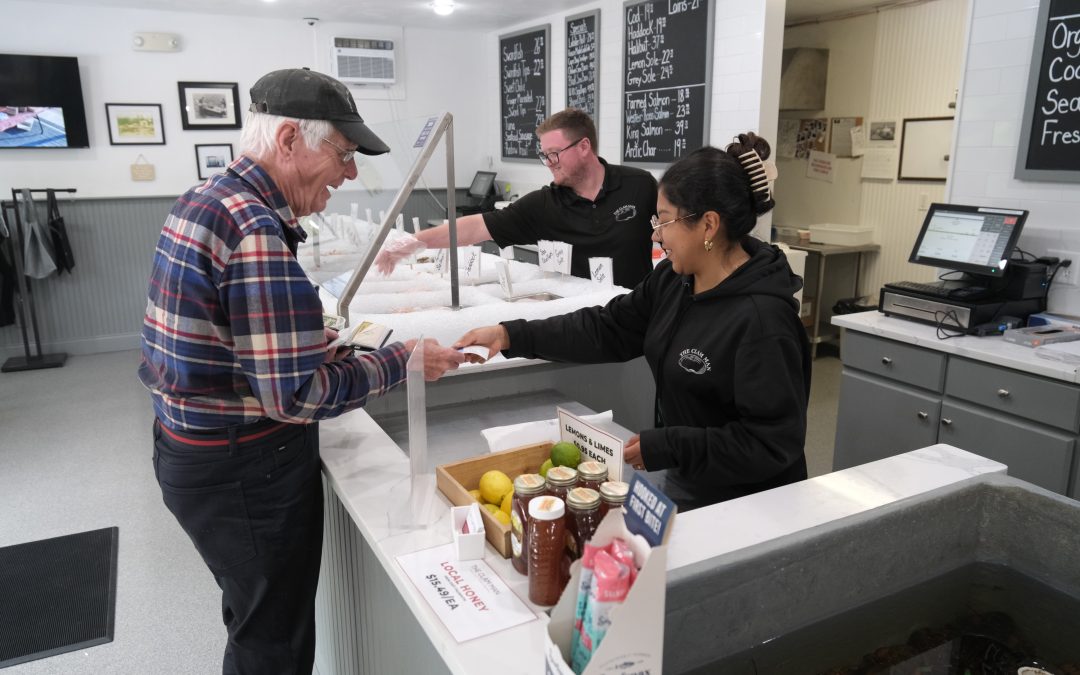Story By CHRISTOPHER KAZARIAN & Photos by GENE M. MARCHAND
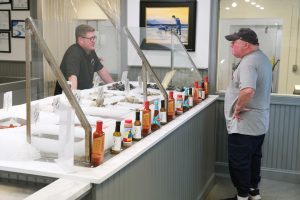
Sam Walker discusses types of oysters with a customer.
It was in Falmouth’s local waters where Matt Rocheleau could often be found during his free time while a student at Falmouth High School in the mid-1980s. He was digging for clams and quahogs, a hobby that turned into something much greater—a career that has become a passion.
Those fledgling days paved the way for what would eventually become The Clam Man, a fish market that supplies seafood to both retail customers as well as nearly 190 restaurants, country clubs, private chefs and institutions throughout Cape Cod and Martha’s Vineyard and off-Cape to Plymouth and Marion.
A short walk from downtown Falmouth, it’s located on a compact street that becomes packed with traffic throughout the year, one sign that digging for clams pays its dividends. “Last Christmas Eve, we sold over 1,100 pounds of cocktail shrimp and that was our shortest day of the year. We closed at 3 o’clock,” Rocheleau said.
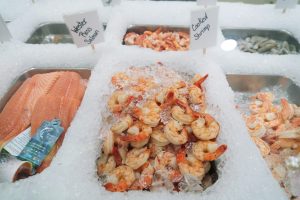 Now celebrating its 31st year in Falmouth, The Clam Man stocks and sells much more than its name implies, part of the impressive growth it has had under Rocheleau’s tenure.
Now celebrating its 31st year in Falmouth, The Clam Man stocks and sells much more than its name implies, part of the impressive growth it has had under Rocheleau’s tenure.
Just six days before the market expanded its hours to seven days a week—the same weekend his youngest son Marc, 26, married his wife Veronika, who manages the store’s social media, in Dallas—Rocheleau spoke with energy and enthusiasm as he gave a tour of The Clam Man’s operations.
“I love the challenge of the job,” he said about what drives him. “Every day is something different.”
What was once a one-man business now requires a year-round staff of 22.
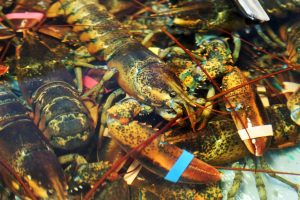 He operates The Clam Man with his wife, Sue, who he met in 1992; Marc, its director of operations; a retail manager; two wholesale managers; four sales staff; six delivery drivers; an in-house executive chef; and an array of retail staff who assist with everything from waiting on customers to filling restaurant orders to cutting fish to processing shellfish.
He operates The Clam Man with his wife, Sue, who he met in 1992; Marc, its director of operations; a retail manager; two wholesale managers; four sales staff; six delivery drivers; an in-house executive chef; and an array of retail staff who assist with everything from waiting on customers to filling restaurant orders to cutting fish to processing shellfish.
Roughly 70 percent of its business, Rocheleau said, is wholesale and the remainder retail. “Wholesale is more volume based, restaurants feeding a lot of people whereas retail is people feeding a few people or just themselves,” he explained.
A typical day starts with its first truck departing to Boston’s Araho Transfer Station, a third-party handler of fresh and frozen seafood, at 5 AM. “We bring the fish back here and the fish gets cut,” he said. “We’re pretty much buying a day ahead, meaning that we’re bringing in whole fish to cut for the next morning.”

Chef J.C. pulls some lobster from the pot.
Its product comes from all over the world—swordfish from South Africa and Ecuador; tuna from Panama; cod and haddock from Iceland; lemon sole from Jeffrey’s Ledge in Gloucester; red grouper and snapper from the Gulf of Mexico; sea scallops from the Gulf of Maine; and black seabass from Maryland.
While much of its fish is wild, it does stock farm-grown products, including salmon from Scotland. “The two farms we deal with are in Wester Ross and Loch Duart,” Rocheleau said. “Those two farms are certified organic sites…. They’re smaller farms and they take a lot of pride in their workmanship.”
Its shellfish include oysters from Duxbury, Wellfleet, Barnstable, Eastham and Falmouth, while the majority of its mussels come from Prince Edward Island. It sells Canadian hard-shell lobsters in a variety of sizes that are housed in a tank in the retail section; there is a second tank in the basement, which is used during the busier months of the year.
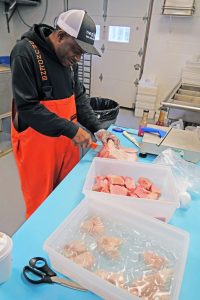
Hugh Stevenson slices some swordfish.
Name a restaurant on Cape Cod and there is a good chance its seafood comes from The Clam Man. Scargo Café in Dennis, Pelham House Resort in Dennis Port, Bucatino’s in North Falmouth, The Captain Kidd in Woods Hole, Taco Blanco in Falmouth, Plymouth Country Club, Margaritaville Resort in Hyannis, Tugboats in Hyannis, The Chart Room in Cataumet, The Pilot House in Sandwich and Leonessa in Yarmouth Port are just some of the local eateries The Clam Man serves.
While extremely busy, when you walk into The Clam Man, you’re struck by how clean and orderly it is, all by design. “I’m a clean freak,” Rocheleau said. “Everything you see is spotless.”
It can be witnessed in the retail section where all of the seafood is iced. “Every day, we take a ton of cubed ice, ground it down into little diamonds and pack it here,” he said, noting the sparkling effect it gives to the display.
Not only does the store sell fresh fish and shellfish, it has its own prepared foods, including chowders, coleslaw, bluefish pate, caviar, salmon pate, sushi, shrimp salad, marinated octopus and lobster salad which, Rocheleau said, “we’re known for. It’s a secret recipe and it’s one ingredient that makes it so special.”
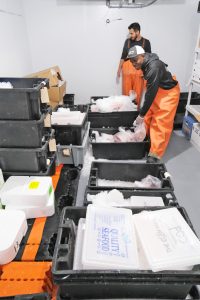
Hugh Stevenson, foreground, and Paulo Freire in the cooler.
An operation like this requires not only resources, but adequate space. While it may look relatively small from the outside, it is an impressive operation from the inside. Matt and Sue bought the building in 2000, tore it down and rebuilt it, combining the market roughly a decade ago with a second property behind it that previously housed the Glass Hut Studio.
The Clam Man is roughly 4,000 square feet, consisting of three freezers; two coolers; a retail market; a wholesale room where fish are weighed, processed, cut and bagged; a room for sorting, counting and bagging shellfish; a kitchen where prepared foods are made; and a loading dock.
One cooler holds the shellfish at a warmer temperature. “If you take them out of a warm estuary and put them into a cooler that’s cold, they actually go into shock,” Rocheleau explained.
The other cooler is strictly for fish. “We keep our fish and shellfish separate just in case of cross contamination,” Rocheleau said, later noting one enhancement to the industry since he first started—the traceability of the product he sells. “Along with the time and temperature, you also know who you bought the fish from, when they harvested it, and who you sold it to,” he said. “That has really come a long way.”
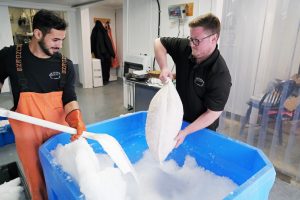
Paulo Freire, left, and wholesale manager Sam Walker unload a shipment.
The store’s newest addition is a state-of-the-art, 24-foot by 30-foot walk-in freezer that has an insulated floor, two compressors and four evaporators. Among the fish inside is 5,000 pounds of its private label shrimp that it orders directly from Vietnam.
No longer is Rocheleau scouring Falmouth’s estuaries for clams, Vineyard Sound for scallops, or Buzzards Bay and Vineyard Sound for lobsters to wholesale. While much has changed, the name that artist Lance Shinkle, known for creating and carving Falmouth’s Carousel of Light, suggested to Matt when he was starting his business—and the sentiment behind that name—are still very much a part of who The Clam Man is.
As to the future of the business, Rocheleau is looking to his son, Marc,who has added fresh ideas and a new energy to The Clam Man. Marc has improved business processes by implementing a live inventory and launching a sales team to increase the business’s reach. There are plans to add a food truck and talk of expanding to a second location.
A 2016 graduate of Falmouth High School who earned his bachelor’s degree in business administration and management from Merrimack College, Marc has grown up in the business. “I just like the hands-on work, and I like to eat fish. It’s something you can touch and you’re not just working at a computer all day,” he said. “And there’s no limit on our growth. We want to be the main supplier of seafood to restaurants and have multiple retail markets on Cape Cod.”


